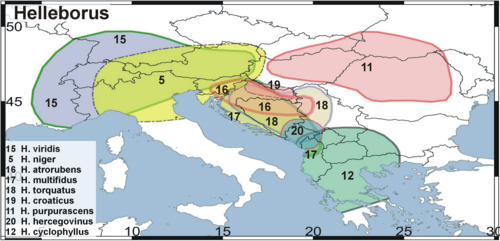hellebore
| hellebore | ||||||||||||
|---|---|---|---|---|---|---|---|---|---|---|---|---|

Snow rose, Christmas rose ( Helleborus niger ) |
||||||||||||
| Systematics | ||||||||||||
|
||||||||||||
| Scientific name | ||||||||||||
| Helleborus | ||||||||||||
| L. |
The plant genus hellebore ( Helleborus ), and Christmas roses , snow roses or Lenten roses , belongs to the family of the buttercup family (Ranunculaceae). The 15 to 25 species are distributed from Europe via Asia Minor to Central Asia and a single species from China.
Origin of name
The German trivial name Hellebore (from Middle High German Hellebore " Black Hellebore , White Hellebore " ) is due to the fact that the grated powder of the subterranean plant parts - like some other plant species, e.g. B. from the genus Veratrum (also named with the plant name "hellebore") - triggers sneezing stimulus (see sneezing ).
The etymology of the scientific name is considered unclear. The generic name Helleborus is derived either from the Greek words hellein = to kill and bora = food or from the Greek words ellós = deer calf and bora = food . The derived term (h) elleborosus = crazy refers to the fact that hellebore was used as a remedy for the insane in ancient times . Sneezing, vomiting, and diarrhea induced by drugs were an important psychiatric remedy well into the 18th century.
description





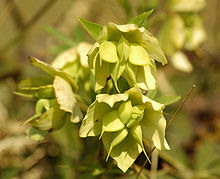



Vegetative characteristics
Helleborus species are perennial herbaceous plants that usually develop rhizomes as persistent organs. The relatively large leaves are divided into a petiole and a leaf blade. The leaf blade is mostly divided.
Generative characteristics
There are one to many flowers on an inflorescence (it is a cyme ). They have deciduous bracts . The hermaphroditic flowers are radial symmetry . The flower colors range from red to purple and white to green. The five sepals are large and decorative in different colors and are usually still present while the fruit is ripening. The 5 to 15 petals are small. There are many (30 to 60) stamens and two to ten free carpels in each flower .
All species are poisonous.
Occurrence
Helleborus species are distributed from Europe via Asia Minor to Central Asia; a species used as a medicinal plant by the first settlers has spread to North America ( green hellebore Helleborus viridis ). Some species and varieties are used as ornamental plants and have become wild in some countries. The species most frequently used as ornamental plants are the snow rose / Christmas rose (H. niger), the oriental hellebore (H. orientalis), purple hellebore (H. purpurascens), the Corsican hellebore (H. argutifolius) and the foul-smelling hellebore (H. . foetidus). These species are popular because of their early and showy flowering in winter and spring and their evergreen leaves.
Some species are under nature protection .
Systematics
The genus Helleborus was established by Carl von Linné . A homonym is Helleborus Gueldenst.
The genus Helleborus belongs to the tribe Helleboreae in the subfamily Ranunculoideae within the family Ranunculaceae .
The following list of the Helleborus species gives names and the year of the first description, if possible a picture, the distribution area, the flower color and the German meaning of the scientific name. The relationships between the Helleborus species and the subspecies and sections are shown in a cladogram (based on Meiners et al.).
| Surname | Common name | Word meaning of the scientific name |
Area of dissemination | Flower color | Illustration |
|---|---|---|---|---|---|
| Subgenus Helleborus | Bracts leaf-like (frondos), seven to three parts, fresh green; Hellebore (remedy for madness and epilepsy; emetics) | ||||
| I. sect. Griphopus Spach em. Schiffner | Foot of a griffin | ||||
|
Helleborus foetidus L. 1753 |
Smelly hellebore | smelly, foul smelling | SW - M Europe | green, widespread red border |

|
| II. Sect. Chenopus Schiffner | tortuous | ||||
|
Helleborus lividus Aiton 1789 |
Majorcan hellebore | lead-colored, bluish | Mallorca | green |

|
|
Helleborus argutifolius Viv. 1824 |
Corsican hellebore often also H. lividus Aiton ssp. corsicus (BRIQ.) P. FOURN. |
richly leaved | Corsica, Sardinia | green, whitish |

|
|
III. sect. Helleborus [sect. Chionorhodon Spach ] |
Snow, rose | ||||
|
Helleborus niger L. 1753 |
Snow rose | black / sharp | Croatia, Slovenia, N Italy, Switzerland, Austria, S Germany | white, later also pink |

|
| subsp. macranthus | H. niger major | white, later also pink | |||
| subsp. niger L. | white, later also pink |

|
|||
| Subgenus Helleborastrum (Spach) Werner & Ebel | Hochblatter scaly (brakteos), undivided, pale green bracts / bracts leafy, 7-3, seeds without elaiosome |
||||
| IV. Sect. Syncarpus Schiffer | similar to the wrist | ||||
|
Helleborus vesicarius Aucher ex Boiss. 1841 |
SE Turkey, NW Syria | red | |||
| V. sect. Dicarpon Ulbrich | not like the wrist | ||||
|
Helleborus thibetanus Franch. 1885 |
Tibet hellebore | China | pink |

|
|
| VI. sect. Helleborastrum Spach | Similarity to Helleborus | ||||
|
Helleborus abruzzicus M.Thomsen, McLewin & B.Mathew |
Abruzzo | Central Italy | whitish, greenish | ||
|
Helleborus atrorubens Waldst. & Kit. 1812 |
dark red | Slovenia, N Croatia, Bosnia, former Yugoslavia |
reddish, purple |

|
|
|
Helleborus bocconei Ten. 1823 |
Botanist Paolo Boccone | S Italy, Sicily | White |

|
|
|
Helleborus croaticus Martinis 1973 |
from Croatia | NO Croatia | reddish purple |
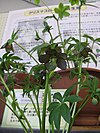
|
|
|
Helleborus cyclophyllus (A.Braun) Boiss. 1867 |
Circle, leaves | Greece, Macedonia Albania, Bulgaria | green, light green, whitish |

|
|
|
Helleborus dumetorum Waldst. & Kit. ex Willd. 1809 |
Hedge hellebore | Slovenia, Hungary, Croatia, Romania, Austria, | green to white |

|
|
|
Helleborus liguricus M.Thomsen, McLewin & B.Mathew |
from Liguria | Italy (Liguria, Tuscany) | green to white | ||
|
Helleborus multifidus Vis. |
much divided | Croatia, Herzegovina | green | ||
| subsp. hercegovinus | from Herzegovina | Montenegro, Hercegovina | yellow-green | ||
| subsp. istriacus | from Istria | Northeast Italy, Croatia, Bosnia, Montenegro | green | ||
| subsp. multifidus | many-sided (pinnate) | Albania and the former Yugoslavia | |||
|
Helleborus odorus Waldst. & Kit. ex Willd. 1809 |
fragrant | South and Southeast Europe with a focus on the Balkan Peninsula |
green to yellow-green |
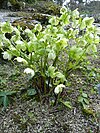
|
|
| subsp. odorus L. | fragrant | ||||
|
Helleborus orientalis Lam. 1789 |
Oriental hellebore | from the east | N Turkey, Bulgaria, Ukraine, Georgia, Caucasus | white, yellowish, pink |

|
| subsp. abchasicus (A. Braun) Mathew |
from Abkhazia | Georgia | pink, reddish |

|
|
| subsp. guttatus (A. Braun & Sauer) Mathew |
dotted |

|
|||
| subsp. orientalis | H. caucasicus, H. kochii | from the Orient | occasionally used for ssp. gutatus + abchasicus | reddish | |
|
Helleborus purpurascens Waldst. & Kit. 1802 |
Purple hellebore | purple / red | Hungary, Slovakia, Poland, Romania | purple, brown |
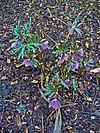
|
|
Helleborus torquatus Archer-Hind 1884 |
adorned with necklace | Croatia, Bosnia, Serbia, Montenegro | green, purple |
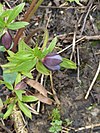
|
|
|
Helleborus viridis L. 1753 |
Green hellebore | green | Austria N Italy, Switzerland, S Germany | green |

|
|
subsp. occidentalis 1869 |
from the West | N Spain SW France (France, Germany, Great Britain feral) | green | ||
|
|||||||||||||||||||||||||||||||||||||||||||||||||||||||||||||||||||||||||||||||||||||||||||||||||||||||||||||||||||||
| Relationships within the genus Helleborus according to Meiners et al. (2011). |
use
Among the hellebore species, the Christmas rose ( Helleborus niger ) and its varieties are used as ornamental plants . The Corsican hellebore with its cup-shaped green flowers is considered to be the species that can best tolerate sun and drought .
In the meantime a number of hybrids have also been bred. These include, for example, the Helleborus 'Queen of the Night' variety , a cross between the oriental hellebore ( Helleborus orientalis ) and the purple hellebore ( Helleborus purpurascens ).
Through their use as medicinal plants, two hellebore species were naturalized in Central Europe . Both the Christmas rose and the green hellebore were carried away via seeds and garden waste and settled in the wild. The green hellebore can be found particularly in the foothills of the Alps in light forests and on the edges of vineyards. The first written evidence comes from 1798.
Hellebore as a poisonous and medicinal plant
Hellebore species contain some pharmacologically important and beneficial ingredients: saponin and the glycosides Helleborein and Hellebrin can be found in the whole plant. Helleborein has a digitalis effect . The smell of the ingredients leads to a strong urge to sneeze .
The toxic effect of hellebore species, including the Ancient and Medieval Age White hellebore ( helleborus albus ) was counted, was already in antiquity known. It is reported that Solon was killed during the First Holy War in 600 BC. BC poisoned a stream with crushed Helleborus rhizomes (probably Helleborus odorus ) and thus incapacitated the inhabitants of Krissa who drank from the stream through diarrhea. Frontinus also refers to the same episode , who in his Stratagema tells of the poisoning of the inhabitants of Krissa with elleboro by the tyrant Kleisthenes of Sicyon . The Herophilos of Chalcedon quoted by Pliny called "helleborus", presumably the white Germer lily plant, in a military metaphor as a "strong general".
Nieswurzen were also often used as a medicinal plant in the past, as one can conclude from the mentions in Hippocrates , Hildegard von Bingen and other medieval sources, Paracelsus , Hieronymus Bock , Pietro Andrea Mattioli and Christoph Wilhelm Hufeland . According to Democritus , the hellebore helped against folly, which was widespread among his fellow citizens, the Abderites .
The plant, which was known as helleborus niger ("black hellebore") in antiquity and the Middle Ages, can still be called Christmas rose (Helleborus niger L.) , smelly / green hellebore (Helleborus foetidus L./viridis L.) and spring adonis rose (Helleborus foetidus L./viridis L.) for the Middle Ages. Adonis vernalis L.) can be interpreted.
The Christmas rose has been grown in gardens as a medicinal plant since the 16th century. The dark brown rhizome was powdered and used as a heart medicine and diuretic medicine. The herbal books of the 16th and 17th centuries also pointed out the toxicity of the plant and warned against overdosing. In Der Klosterjäger by Ludwig Ganghofer, the eponymous hero warns a brother to whom he should bring the hellebore: “Two drops make red, ten drops make dead.” The consumer goods ordinance forbids use as sneeze powder .
Use in art and culture
The alleged effects of hellebore are mentioned in art and literature from ancient times. In Ovid's Metamorphoses , in the library of Apollodorus and in Virgil , the cure of Melampus is reported. The doctor cured Iphianassa and Lysippe , daughters of King Proitus of Argos, of their madness (they believed they were cows and ravaged the land) by giving them milk with a hellebore to drink. In the comedy Menaechmi von Plautus (250–184 BC) the doctor says to the patient ... you will drink hellebore for about 20 days ... to which the patient replies ... but I am not crazy . Tantalos also hoped for a cure for his tormenting desire through this root: You are right about that: That alone accounts for part of my damnation that I am tormented by the desire to drink without needing it. Menippos reacts: You babble, Tantalos! You do need a potion, but none other than the strongest hellebore. Your evil is precisely the contradiction of what happens to those bitten by angry dogs: They shy away from water, you from thirst. Tantalos, in turn, refers to the hellebore: if I only had a good sip of Helleborus, I would certainly not want to spurn it! Five grains of hellebore are recommended in Heinrich von Kleist's Amphitryon for mental illness, but also as six grains d'ellébore in the treatment of the Amphitryon by Molière.
In the Parzival des Wolfram von Eschenbach around 1205, the hellebore (possibly related to the stinking hellebore species ) is also mentioned in relation to the stabbing pain it causes in the nose; and in the perfumed garden of “Sheikh Nefzawi”, hellebore is described in the 15th century as an additive to wine with an erotic effect.
Supposedly we owe the song Es ist ein Ros sprung from the monk Laurentius, who was inspired by the sight of a Christmas rose (black hellebore, Helleborus niger ) on a winter hike .
literature
- Heinz-Dieter Krausch : Imperial crown and peonies red ... - Discovery and introduction of our garden flowers. Dölling and Galitz, Hamburg 2003, ISBN 3-935549-23-7 .
- Gisela Schmiemann: Helen Ballard, The Hellebore Queen. Edition Art and Nature, Cologne 1997, OCLC 245791392
- Jaakko Jalas, Juha Suominen (ed.): Atlas Florae Europaeae. Distribution of Vascular Plants in Europe. Volume 8: Nymphaeaceae to Ranunculaceae. Akateeminen Kirjakauppa, The Committee for Mapping the Flora of Europe & Societas Biologica Fennica Vanamo, Helsinki 1989, ISBN 951-9108-07-6 , pp. 24-29.
- Christian Hünemörder: Helleborus. In: The New Pauly. Volume 5, 1998, Col. 299.
Individual evidence
- ↑ Jürgen Martin: The 'Ulmer Wundarznei'. Introduction - Text - Glossary on a monument to German specialist prose from the 15th century. Königshausen & Neumann, Würzburg 1991 (= Würzburg medical-historical research. Volume 52), ISBN 3-88479-801-4 (also medical dissertation Würzburg 1990), p. 154.
- ^ Ferdinand Wick: Contributions to the history of Helleborus and Veratrum. Phil. Diss. Basel 1939.
- ↑ Helmut Genaust: Etymological dictionary of botanical plant names. 3rd, completely revised and expanded edition. Nikol, Hamburg 2005, ISBN 3-937872-16-7 , p. 284 (reprint from 1996).
- ^ Karl Ernst Georges: Comprehensive Latin-German concise dictionary. 8th edition. Volume 1, Hahn, Hannover 1913, Sp. 2389, (online at: zeno.org ) .
- ^ Bangen, Hans: History of the drug therapy of schizophrenia. Berlin 1992, ISBN 3-927408-82-4 p. 15
- ↑ Helleborus at Tropicos.org. Missouri Botanical Garden, St. Louis, accessed August 1, 2015.
- ^ Helleborus in the Germplasm Resources Information Network (GRIN), USDA , ARS , National Genetic Resources Program. National Germplasm Resources Laboratory, Beltsville, Maryland. Retrieved August 1, 2015.
- ↑ a b Klaus Werner and Friedrich Ebel: “On the life history of the genus Helleborus L. (Ranunculaceae)”, Flora (1994) 189, pp. 97–130, doi.org/10.1016/S0367-2530(17)30578-9
- ^ A b c Julia Meiners, Thomas Debener, Guenther Schweizer, Traud Winkelmann: "Analysis of the taxonomic subdivision within the genus Helleborus by nuclear DNA content and genome-wide DNA markers", Scientia Horticulturae 128 (2011) pp. 38–47, [1]
- ↑ Walter K. Rottensteiner: “Attempt of a morphological differentiation of Helleborus species in the Northwestern Balkans”, Modern Phytomorphology 9 (Suppl.) (2016), pp. 17–33, [2]
- ↑ Description of all Hellebores species (in English), Internet publication ( [3] ), last accessed on August 20, 2019.
- ^ Ferdinand Peter Moog: On the parable of the brave general in Herophilos. In: Würzburg medical history reports. Volume 22, 2003, pp. 30-39, here: pp. 31-36.
- ^ Frontinus, Stratagema III, 7.
- ^ Ferdinand Peter Moog: On the parable of the brave general in Herophilos. In: Würzburg medical history reports. Volume 22, 2003, pp. 30-39.
- ^ Karl Sudhoff : A German instruction on the medicinal use of the hellebore (Helleborus) from the 14th century. In: Sudhoffs Archiv 1, 1908, p. 446 f.
- ↑ See Cicero's saying "Hic Abdera" in "Epistulae ad Atticum", 4,16,6 meaning "This is where stupidity is at home"
- ↑ Ulrich Stoll: De tempore herbarum. Vegetable remedies as reflected in the herbal collection calendars of the Middle Ages: an inventory. In: Peter Dilg, Gundolf Keil, Dietz-Rüdiger Moser (eds.): Rhythm and Seasonality. Congress files of the 5th symposium of the Medievalist Association in Göttingen 1993. Sigmaringen 1995, ISBN 3-7995-5404-1 , pp. 347-375, here: p. 360.
- ↑ The legendary Christmas rose in historical representations. In: André Schüller-Zwierlein, Regensburg University Library. 2011, accessed November 18, 2019 .
- ^ The twins (Menaechmi) according to Plautus, in the meter of the original by JJC Donner, Leipzig and Heidelberg, CF Winter'sche Verlagshandlung, 1865 under: Projekt Gutenberg , accessed: March 13, 2013
- ↑ Lukian of Samosata : Talks with the dead. Seventeenth conversation in the Gutenberg-DE project
- ^ Heinrich von Kleist: Amphitryon. (1961), p. 171 (2nd act, second scene)
- ^ Molière: Amphitryon. acte II, scene II, vs. 940
- ↑ Britta-Juliane Kruse: Hellebore and deer root in the Parzival Wolframs von Eschenbach. In: Würzburg medical history reports. Volume 14, 1996, pp. 279-286.
- ↑ A crazy rose. In: Westfälische Wilhelms-Universität Münster, uni-muenster.de. 2010, accessed November 18, 2019 .


